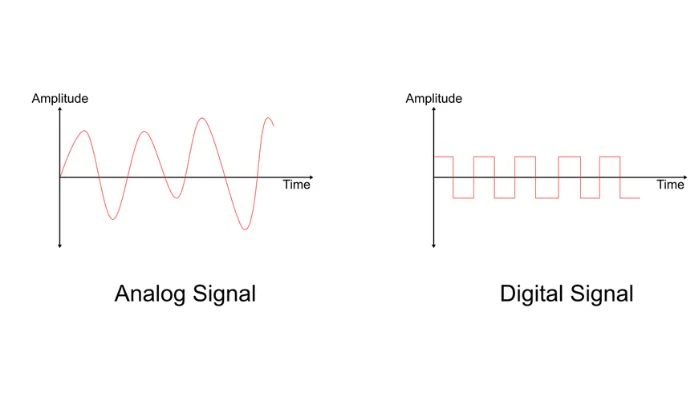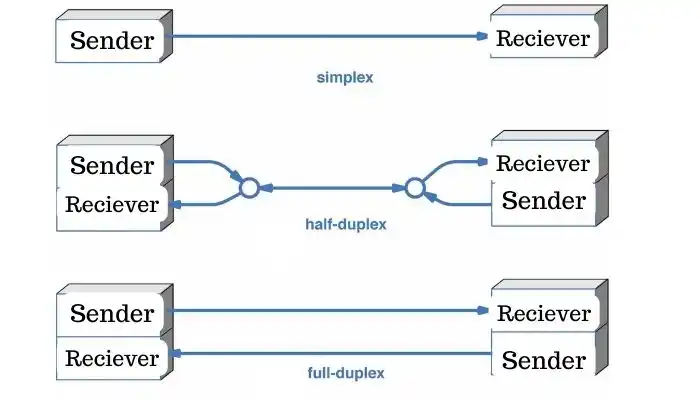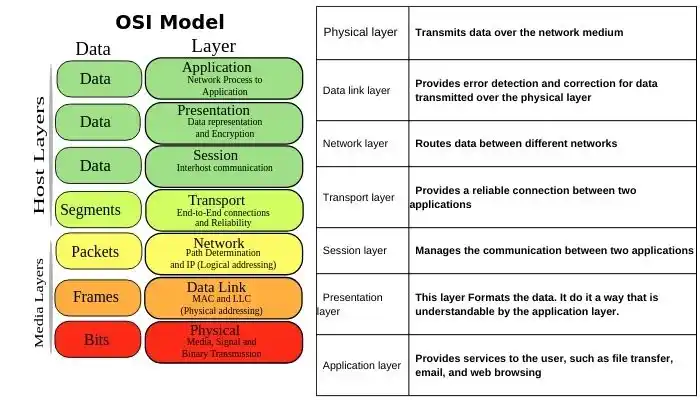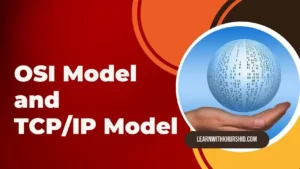Data Communication and Networking: Data communication and networking is a computer science branch. Here we study data transmission between computers and other electronic devices. These devices are cables, routers, hubs, repeaters, and switches. The protocols govern how data is transmitted over a network. The software that is used to manage and control a network. The security of data in transit and at rest. In this article, we will explain the basics of data communication and networking, types of data communication and their protocols, networking fundamentals, transmission media, network topologies, network models, cloud computing, virtual private networks (VPN), network design, implementation, and management, internet of things (IoT), advances in networking, and the future of networking.
Overview of Data Communication and Networking
What is Data Communication?
When the exchange of information between two or more devices or endpoints is known as Data communication. It involves the transmission, reception, and processing of data via different communication channels, such as wired or wireless connections.
What is Networking?
Computer Networking is nothing but an interconnection of computing devices that can exchange data and share resources with each other. Computer Networking uses some rules and regulations to communicate known as protocols. This allows for sharing of resources such as printers, files, and internet connections.
Types of Data Communication
Analog vs Digital Communication

Analog communication refers to the transmission of data in the form of continuous signals, such as voice signals. Digital communication refers to the transmission of data in the form of discrete signals, such as binary code (0 1 0 1).
Simplex, Half Duplex, and Full Duplex Communication

- Simplex communication allows for communication in one direction only
- Half-duplex communication allows for communication in both directions, but not simultaneously.
- Full-duplex communication allows for simultaneous communication in both directions.
Wired vs Wireless Communication
When data is transmitted via physical cables or wire is known as Wired communication. And when data is transmitted via wireless channels such as Wi-Fi and Bluetooth is known as Wireless Communication.
The Role of Protocols in Data Communication
Meaning and Importance of Protocols
A set of rules and standards that govern the communication between different devices on a network is known as Networking protocols. The computer protocols will transmit the data consistently and uniform manner without bothering different types of devices or networks.
OSI and TCP/IP Model

The OSI model and TCP/IP model are two commonly used reference models for networking protocols. The OSI model and TCP/IP model are two commonly used reference models for networking protocols. These two models provide a framework for the development of devices and their software, implementation, and operation of network protocols.
The OSI model is a more comprehensive model that provides a clear separation of concerns. Each layer has a specific role to play in the transmission of data.
The TCP/IP model is a very simple model implement. It is also more widely used, as it is the underlying protocol for the Internet.
Key differences between the OSI model and TCP/IP
| Feature | OSI Model | TCP/IP Model |
| Number of layers | 7 | 4 / 5 |
| Layer separation | Clear separation of concerns | Less clear separation of concerns |
| Implementation complexity | More complex | Less complex |
| Flexibility | More flexible | Easier to implement |
| Ease of implementation | Less easy to implement | More easy to implement |
| Widespread use | Less widely used | More widely used |
Functions of each layer of the OSI model
| Layer | Function |
| Physical layer | Transmits data over the network medium |
| Data link layer | Provides error detection and correction for data transmitted over the physical layer |
| Network layer | Routes data between different networks |
| Transport layer | Provides a reliable connection between two applications |
| Session layer | Manages the communication between two applications |
| Presentation layer | This layer Formats the data. It does it in a way that is understandable by the application layer. |
| Application layer | Provides services to the user, such as file transfer, email, and web browsing |
Layers, Functions, and Communication Protocol
OSI contains 7 layers and TCP/IP contains 4 layers in the old version and 5 layers in the old version. These multiple layers perform their own function with different communication protocols. Each layer is responsible for a specific task, such as data compression, error correction, or data routing.
Read also: The Basics of File Systems: 3 File System FAT, NTFS, and exFAT
Networking Fundamentals
Introduction to Networking Devices
Networking devices are hardware components that are used to connect different devices on a network. The most common networking devices include hubs, switches, routers, and modems.
TCP/IP Addressing and IP Addressing Classes
An Internet addressing scheme that will allow users and applications to identify a specific network or host. It helps to communicate what is known as TCP/IP addressing IP addressing classes define the range of IP addresses that can be assigned to devices based on their network requirements.
TCP/IP Addressing
- Two TCP/IP Addressing are there 1. Physical Address 2. Logical Address
- Physical Address – It is a MAC address of 48 bits
- Logical Address – Two types of it 1. IPv4 (Public IP and Private IP) 2. IPv6
IPv4 – It is a 32 bits logical address. It contains 4 octets. Each octet is of 8 bits.
An IP address is the combination of Network Id and Host Id
Classes of IPv4 addressing
Class A
- Public IP Range: 1.0.0.0 to 127.0.0.0
- Private IP Range: 10.0.0.0 to 10.255.255.255
Class B
- Public IP Range: 128.0.0.0 to 191.255.0.0
- Private IP Range: 172.16.0.0 to 172.31.255.255
Class C
- Public IP Range: 192.0.0.0 to 223.255.255.0
- Private IP Range: 192.168.0.0 to 192.168.255.255
Class D
- Range: 224.0.0.0 to 239.255.255.255
- The Class D IP addresses are not hosts it is used for multicasting.
Class E
- Range: 240.0.0.0 to 255.255.255.255
- class E are reserved for research purposes.
Note: 127.0.0.0 is used for Loopback address
Transmission Media in Networking
Electrical Signals Transmission
The Electrical Signals Transmission is done through network cables using different types of modulation techniques, such as amplitude modulation and frequency modulation.
Twisted Pair Cabling
The Twisted pair cable is a network cable that consists of twisted pairs of copper wires. It is used to transmit data over short distances.
Coaxial Cabling, Fiber Optic Cabling
Coaxial cabling and fiber optic cabling are used to transmit data over longer distances. Coaxial cables consist of a copper core surrounded by insulation and braided wire, while fiber optic cables use light to transmit data.
Wireless Transmission
Wireless transmission uses radio waves to transmit data between devices without the need for physical cables.
Network Topologies
Network topologies refer to the physical or logical arrangement of devices in a network. The most common network topologies include bus topology, ring topology, star topology, mesh topology, tree topology, and hybrid topology.
There are 6 types of topologies
Bus topology
In a bus topology, devices are connected to a common cable called the bus. The devices share this cable, and data can be transmitted in both directions. It is used in small networks, and its low cost makes it a popular option for small businesses.
Ring topology
In a ring topology, devices are connected to other devices in a circular manner. The data travels in a circular path, and each device receives and passes on the data to its neighboring device.
Star topology
In a star topology, devices are connected to a central hub or switch. These devices are connected to the hub using a separate cable. The devices do not share a cable, and data is transmitted through the hub or switch.
Mesh topology
In a mesh topology, each device is connected to every other device on the network. It ensures a reliable network as data can be transmitted through multiple paths.
Tree topology
The Tree topology looks like a tree. In a tree topology, there is only one main node (the “trunk”), and each of these nodes is connected to the main node through a single path. Nodes are like end devices.
Hybrid topology
In a hybrid topology, two or more different physical topologies are combined. It provides the advantages of the different topologies used.
Network Models
Client-Server Model
In the client-server model, there is a central server and there are clients connected to a central server. The server manages and controls access to network resources.
Peer-to-Peer Model
The peer-to-peer model is nothing but a network model in which devices are connected to each other in a decentralized manner. In this model, each device acts as both a client and a server.
Cloud Computing
What is Cloud Computing?
When the delivery of computing resources done over the Internet on a pay-per-use basis is known as Cloud computing. These resources are servers, storage, software, and applications.
Types of Cloud Computing
There are 3 types of Cloud Computing
- Infrastructure as a service (IaaS) – This cloud computing service model provides fundamental computing resources. Its service includes processing, storage, and networking, over the Internet. These cloud computing services save the money of an organization.
- Platform as a service (PaaS) – This cloud computing model provides a development environment for building, testing, and deploying applications.
- Software as a service (SaaS). – This cloud computing model delivers software licensed on a subscription basis and is centrally hosted. It is known as on-demand software services and web-based software.
Advantages and Disadvantages of Cloud Computing
The advantages of cloud computing include cost savings, scalability, mobility, and automatic updates.
Disadvantages include security concerns, possible downtime, and data sovereignty concerns.
Virtual Private Network (VPN)
What is a VPN?
A VPN (virtual private network) creates a digital (secure and encrypted) connection between a computer and a remote server owned by a VPN provider. This will create a point-to-point tunnel that will encrypt personal data. It will mask the IP address and let you be on the website.
How VPN works?
A VPN encrypts the data being transmitted and routes it through a secure tunnel. This ensures that the data being transmitted cannot be intercepted by unauthorized users.
VPN Protocols
This protocol is a ruleset and is used to establish a secure connection between devices.
Examples: VPN protocols include PPTP, L2TP, IPSec, and OpenVPN.
Network Design, Implementation, and Management of Data Communication and Networking
Network Requirements
Network requirements refer to the specific needs of a network, such as bandwidth, security, and reliability.
Site Survey
A site survey is conducted to determine the best location for networking equipment and to identify any potential issues or obstacles that may affect network performance.
Installation and configuration of Network Devices
Installation and configuration of network devices involve setting up hardware components (routers and switches, connecting cables, and configuring network settings).
Troubleshooting and Maintenance
Troubleshooting and maintenance will identify and resolve network issues if any. It will upgrade hardware and software components, and perform routine maintenance tasks.
Internet of Things (IoT)
Meaning and Importance of IoT
The Internet of Things is a technology that allows us to add a device to the Internet. For example vehicles, plant electronic systems, roofs, lighting, etc.).
IoT Applications
IoT applications include smart homes, wearables, connected cars, and industrial automation.
IoT Architecture and Device Layers
IoT architecture includes three layers: the perception layer, the network layer, and the application layer. IoT devices include sensors, actuators, and gateways.
Advances in Networking and Data Communication
SDN-Software Defined Networking
Software Defined Networking is a networking architectural approach. It uses the software application to manage and configure network infrastructure. It uses open APIs to control the entire network.
Network Functionality Virtualization (NFV)
Network function virtualization (NFV) involves virtualizing network functions, such as firewalls and routers, in order to reduce hardware costs and increase flexibility.
Cloud Networking
The usage of cloud-based networking services is known as Cloud networking. These services are virtual private clouds and load balancing. It manages the network infrastructure.
Future of Networking
Emerging Technologies
The technologies of 5G, artificial intelligence, and blockchain are revolutionizing the interaction of networks and their devices.
Impact of Networking on Society and Economy
The impact of networking on society and the economy has been huge. It will continue to grow as networking technologies continue to evolve.
Challenges and Opportunities
The future of networking presents both challenges and opportunities. These challenges and opportunities need to improve security and increased collaboration between different industries.
Conclusion: Data Communication and Networking
Data communication and networking are critical components of modern technology. It enables us to connect with each other, share information, and access resources on a global scale. If anybody want to seek to participate in the digital world then it is mandatory to know the basics of it. In the above given information, we hope that you get a comprehensive overview of the fundamentals of data communication and networking.
Summary of Key Concepts of Data Communication and Networking
- Data communication involves the exchange of information between devices or endpoints.
- Networking connects devices to create networks that allow for sharing of resources.
- Protocols are sets of rules and standards that govern communication between different devices on a network.
- Wire Transmission media – physical cables (Twisted pair cable, coaxial cable, Fiber optics)
- Wireless Transmission media – Wifi, Bluetooth, Microwave, Radio wave, Infrared
- Network topologies refer to the physical layout and structure of a network.
- The OSI and TCP/IP models provide a framework for the development, implementation, and operation of network protocols.
- Cloud computing delivers computing resources over the internet on a pay-per-use basis.
- Virtual Private Network allows users to connect to a private network over the internet in a secure and encrypted way.
- Network design, implementation, and management involve identifying network requirements, installing and configuring network devices, troubleshooting, and maintenance.
- The Internet of Things (IoT) connects everyday devices and objects to the Internet.
- Advances in networking include software-defined networking, network function virtualization, and cloud networking.
- Emerging technologies – 5G, artificial intelligence, and blockchain, are expected to revolutionize the way we interact with networks and devices.
FAQ: Data Communication and Networking
What is the difference between Data Communication and Networking?
The exchange of information between devices is known as Data communication while the connection of devices to create a network is known as Networking. Networking allows its user to share resources.
What are the networking devices and their functions?
Networking devices include hubs, switches, routers, and modems. Hubs are used to connect multiple devices to a network, switches allow for communication between different devices on a network, routers connect different networks together and manage network traffic, and modems convert digital signals into analog signals and vice versa.
Explain the different types of transmission media in networking.
Transmission media in networking include physical cables, such as Ethernet cables, and wireless channels, such as Wi-Fi and Bluetooth. Physical cables are used for wired communication, while wireless channels are used for wireless communication.
What is the client-server model?
The client-server model is a common type of network model. This model connects the devices to a central server which will manage and controls the access to network resources.
What is a Virtual Private Network?
A virtual private network is a secure and encrypted connection. It allows users to connect to a private network over the internet.
What is Cloud Computing?
Cloud computing delivered computing resources. These resources are servers, storage, software, and applications, over the internet on a pay-per-use basis.
What is IoT?
The Internet of things (IoT) refers to the connection of everyday devices and objects to the Internet.
What are the Emerging Technologies in Networking?
Emerging technologies in networking include 5G, artificial intelligence, and blockchain, among others. These are the technologies that will revolutionize the way we interact with networks and devices.

